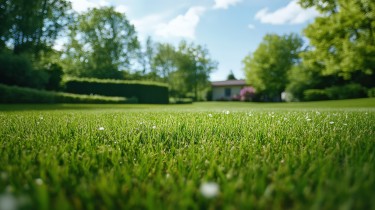

Discover the Secret to a Lush and Healthy Lawn
Read More ›
Blog
Follow these eight simple tips to grow an amazing turf

A beautiful lawn improves your property value and your home’s curb appeal. Plus it looks fresh and clean — and does wonders for the environment!
But how do you get to that beautiful, thick, lush lawn?
One of the first places to start is with your lawn-mowing technique. Mowing your lawn well is about a lot more than pushing your mower around. When and how you mow your lawn play an important role in helping it thrive.
Here are our top eight tips for lawn mowing straight from the Brandon Rushing team’s lawn care experts.
Has it rained recently, or is it going to rain when you want to mow?
Mowing a wet lawn can be dangerous for you and bad for your grass. Not only could you slip and fall, but the grass can clump and become susceptible to disease.
Also, avoid the heat. When it’s hot, the grass loses more water and recovers slower.
Due to the “heat factor,” the best time of day to mow during the warm summer months is either:

Before you start mowing, make sure your blade is sharp and set between 3.5” to 4.5”. Our crews cut to 3.75” in the spring and fall and 4.25” in the summertime. We’ve seen great success with these mowing heights.
Some people like to cut really short so they don’t have to mow as often, but this stresses the grass, leaving it open to disease, pests, thinning, and any number of things you want to avoid.
When mowing, you should cut about a third of the length off and have to mow every seven days. If you’ve waited too long and have overgrown grass, cut about a third of it off, wait a few days, then cut another third until you're down to about 3.5” to 4.5”.
You can start mowing fresh sod 7–14 days after sod installation, or when the grass reaches 4” (depending on the season and growth rates). Keep the blade height at 3.5” to 4.5” and eliminate traffic on the fresh sod until it’s become established after a few mowings.
For seeded areas, don’t mow until the grass blades are at 4”, and avoid traffic on the area until it’s mature.
We advise mowing in different directions or patterns every time you mow.
Grass tends to grow in the direction it’s mowed, so if you mow one direction one week, then the opposite direction the following week, you should get nice, straight blades, and a good, thick look to your lawn.

We don’t want you to leave large clumps of grass on your freshly mowed lawn if you’ve just mowed an overgrown yard. Smaller clippings, on the other hand, can be really beneficial if you’re mowing regularly.
Those small clippings decompose quickly and release nutrients into the soil that can account for up to 25% of your lawn’s fertilizer needs.
If you have a string trimmer, trim around edges and obstacles to finish things off with a manicured look.
Make sure your mower is ready for its next tour of duty. Check the blades to make sure they’re good and sharp. Dull blades rip away at the grass, so the cut is not clean, potentially allowing disease to seep in.
While all of these tips are sure to give you a gorgeous lawn if you follow them all, you might want to leave it to the experts instead.
Brandon Rushin’s lawn care program includes weekly mowing, trimming and edging along with a whole host of other services.
See the program details here or get a free online quote here!
Written by Brandon Rushing, Founder & President
Posted on: June 3rd, 2021